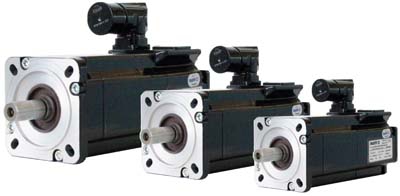
NUM Corp. announces two new brushless servomotor ranges for CNC machinery applications which provide major savings by eliminating the need for a separate encoder cable. Machine builders can now use a single drive-to-motor cable for each motion axis, thereby reducing cabling, speeding installation/commissioning, and improving system performance.
NUM estimates that for a typical high-end CNC machine installation involving 20 metre cable lengths, the new technology can reduce total motor cabling costs by as much as 20 percent per axis.
Available in 75, 95, 126 and 155mm frame sizes and three different lengths, the new SHX and SPX brushless servomotors offer machine builders a wide choice of output power and speed ratings to match different machinery applications. Both motor ranges feature high mass moments of rotor inertia, optimized for machine tool feed axes, and combine excellent dynamic performance with very smooth running, even at low speeds. The SHX range is intended mainly for cost-sensitive applications and includes models with continuous torque outputs from 1.2 to 20 Nm. For applications demanding motors with maximum power-to-volume ratios and a high degree of protection (IP67), such as high-end machine tools, grinding machines and robotics, the SPX range offers units with continuous torque ratings from 1.4 to 23 Nm.
Developed for use with NUM's latest-generation NUMDrive X digital servodrives and Flexium+ CNC platform, SHX and SPX brushless servomotors only require a single cable connection. An innovative embedded digital interface scheme allows the encoder power and position feedback data, together with diagnostic information and thermal data from the motor's temperature sensor, to be carried on just two shielded wires contained within the motor's power cable. This approach has significant advantages for machine builders. In addition to lower cabling costs, cable chains are smaller and lighter, the onerous task of installing and debugging cable runs is much less time consuming, and the reduced number of interconnections improves reliability and immunity to electromagnetic interference.
All SHX and SPX brushless servomotors offer a choice of single- or multi-turn digital encoders with medium, 20-bit (1,048,576 positions per turn) resolution and plus/minus 60 arcseconds accuracy. Backed by the precision control capabilities of NUM's new Flexium+ CNC kernel, this level of encoder performance facilitates very smooth interpolated move profiles and fine adjustment of speed. Both encoders are also available in safety versions, which return position and redundant position data to the servodrive using a secure certified protocol, and comply with the EN 61800-5-2 functional safety standard to SIL 2. NUM is also currently developing a range of high resolution 23-bit digital encoders featuring an accuracy of better than plus/minus 45 arcseconds, for applications demanding ultra precise positioning.
Designers implementing machine safety schemes gain considerable benefit from the tight functional integration of SHX/SPX servomotors and NUMDrive X servodrives. Each drive module can incorporate a variety of safe motion monitoring functions such as Safe Torque Off, Safe Stop 1 and 2, Safely-Limited Speed, etc, with all critical system operations overseen by a centralized safety PLC that forms an integral part of the Flexium+ CNC system. This modular approach is very cost-effective, allowing high integrity safety functions to be implemented on individual machine axes with minimal additional components.
As standard, SHX motors have varnish impregnated housings with an IP64 rating, and their shafts are protected to IP54. The SPX motors feature a special corrosion resistant coating, and both the housings and shafts have an IP67 rating. If even higher levels of shaft protection are required for applications involving direct exposure to fluids such as cutting oils, the motors can be pressurized by connection to a compressed air supply. All SHX and SPX brushless servomotors are available with plain or keyed shafts, an optional electrically actuated permanent magnet holding brake, and a choice of stator winding configurations. Designed for use in ambient temperatures between 0 and 40 degrees Celsius, the motors can also be operated at up to 55 Celsius with appropriate power de-rating.
Related Glossary Terms
- computer numerical control ( CNC)
computer numerical control ( CNC)
Microprocessor-based controller dedicated to a machine tool that permits the creation or modification of parts. Programmed numerical control activates the machine’s servos and spindle drives and controls the various machining operations. See DNC, direct numerical control; NC, numerical control.
- feed
feed
Rate of change of position of the tool as a whole, relative to the workpiece while cutting.
- grinding
grinding
Machining operation in which material is removed from the workpiece by a powered abrasive wheel, stone, belt, paste, sheet, compound, slurry, etc. Takes various forms: surface grinding (creates flat and/or squared surfaces); cylindrical grinding (for external cylindrical and tapered shapes, fillets, undercuts, etc.); centerless grinding; chamfering; thread and form grinding; tool and cutter grinding; offhand grinding; lapping and polishing (grinding with extremely fine grits to create ultrasmooth surfaces); honing; and disc grinding.
- robotics
robotics
Discipline involving self-actuating and self-operating devices. Robots frequently imitate human capabilities, including the ability to manipulate physical objects while evaluating and reacting appropriately to various stimuli. See industrial robot; robot.






